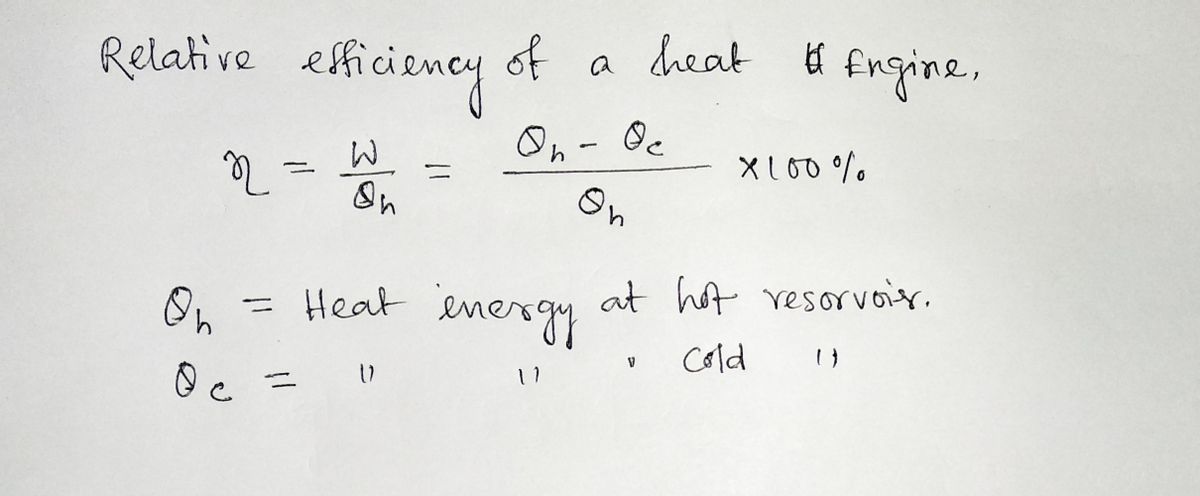
College Physics
11th Edition
ISBN: 9781305952300
Author: Raymond A. Serway, Chris Vuille
Publisher: Cengage Learning
expand_more
expand_more
format_list_bulleted
Question
⦁ An engine has a hot reservoir that contains 20,000 J of heat energy at 3270 C, and a cold reservoir that contains 12,000 J of heat energy at 270 C. What is the relative efficiency of this engine?
⦁ 80%
⦁ 70%
⦁ 60%
⦁ 50%
⦁ 40%
Expert Solution
arrow_forward
Step 1

Step by stepSolved in 2 steps with 2 images

Knowledge Booster
Learn more about
Need a deep-dive on the concept behind this application? Look no further. Learn more about this topic, physics and related others by exploring similar questions and additional content below.Similar questions
- An uninsulated container holds 3.5 mol of an ideal gas at an initial temperature of 300 K. The gas is compressed by a movable piston, and 500 J of work is done on the gas while being compressed. If the final temperature of the gas is 400 K, how much heat flows in or out of the gas during this process?arrow_forwardAn ice cube at 0.0°C is slowly melting. What is the change in the ice cube’s entropy for each 5.80 g of ice that melts? Latent heat of fusion of ice is 333.7 J/g.arrow_forwardCopy of A heat engine is used to convert heat into work. If it draws heat from a bath at 500 K, converts it to work, then delivers the remaining heat into a bath at 300 K, what is its maximum possible efficiency? 20% 30% 40% 60% 70% 80% O O O O Oarrow_forward
- Calculate the maximum efficiency of an engine operating between 60 C° and 160 C°. 28% A 30% .B 23% .C 16% .D Oarrow_forwardA Carnot refrigerator operates with an efficiency n = 0.66666666666667 between a hot reservoir at temperature T₁ = 50 K and a cold reservoir at temperature T2. Calculate the temperature T₂ of the cold reservoir. Select one: O a. T₁ O b. T₁ = 150.0 O d. T₁ = = 25.0 O c. T₁ 16.666666666667 = = 20.0arrow_forwardProblem 2: This problem compares the energy output and heat transfer to the environment by two different types of nuclear power stations—one with the normal efficiency of 36 %, and another with an improved efficiency of 47 %. Suppose both have the same heat transfer into the engine in one day, 2.5 × 1014 J Part (a) How much more electrical energy is produced by the more efficient power station? Part (b) What is the change in the heat transfer to the environment after the upgrade to the more efficient power station?arrow_forward
- A sealed cylinder has a piston and contains 8.90×103 cm3 of an ideal gas at a pressure of 7.50 atm. Heat is slowly introduced, and the gas isothermally expands to 1.70×104 cm3. How much work ? does the gas do on the piston?arrow_forwardA power plant uses natural gas energy to heat up steam. The steam at 400 deg C generates electric power, then is condensed, and the water is cooled to 30 deg C. The cycle repeats. The maximum possible efficiency of electricity generation is %.arrow_forwardYou design an engine that takes in 1.50x104 J of heat at 650 K in each cycle and rejects heat at a temperature of 290 K. The engine completes 240 cycles in 1 minute. What is the theoretical maximum power output of your engine, in horsepower? 1 Watt = 1 Joule/s = 0.00134102 horsepower 44.5 hp 15.0 hp 6.50 hp 2.90 hparrow_forward
- The first law of thermodynamics, ΔU = Q - W, when written as Q = W + ΔU, says that the heat into a system can be used to do work and/or increase the internal energy. Therefore, which process requires the most heat? Isobaric, isochoric, or adiabatic?arrow_forwardConsider a heat pump that is used to cool down a home during the summer. Its coefficient of performance in cooling mode is 5.81. On a particularly hot day, the temperature outside the home is 90◦F, and the temperature inside the home is maintained at 70◦F. If the heat pump consumes 500 W of electrical power, at what rate does it remove heat (W) from the home?arrow_forwardWhen 1.60 x 105 J of heat transfer occurs into a meat pie initially at 20.0°C, its entropy increases by 475 J/K. What is its final temperature (in degrees)? 100.36 X °Carrow_forward
arrow_back_ios
SEE MORE QUESTIONS
arrow_forward_ios
Recommended textbooks for you
 College PhysicsPhysicsISBN:9781305952300Author:Raymond A. Serway, Chris VuillePublisher:Cengage Learning
College PhysicsPhysicsISBN:9781305952300Author:Raymond A. Serway, Chris VuillePublisher:Cengage Learning University Physics (14th Edition)PhysicsISBN:9780133969290Author:Hugh D. Young, Roger A. FreedmanPublisher:PEARSON
University Physics (14th Edition)PhysicsISBN:9780133969290Author:Hugh D. Young, Roger A. FreedmanPublisher:PEARSON Introduction To Quantum MechanicsPhysicsISBN:9781107189638Author:Griffiths, David J., Schroeter, Darrell F.Publisher:Cambridge University Press
Introduction To Quantum MechanicsPhysicsISBN:9781107189638Author:Griffiths, David J., Schroeter, Darrell F.Publisher:Cambridge University Press Physics for Scientists and EngineersPhysicsISBN:9781337553278Author:Raymond A. Serway, John W. JewettPublisher:Cengage Learning
Physics for Scientists and EngineersPhysicsISBN:9781337553278Author:Raymond A. Serway, John W. JewettPublisher:Cengage Learning Lecture- Tutorials for Introductory AstronomyPhysicsISBN:9780321820464Author:Edward E. Prather, Tim P. Slater, Jeff P. Adams, Gina BrissendenPublisher:Addison-Wesley
Lecture- Tutorials for Introductory AstronomyPhysicsISBN:9780321820464Author:Edward E. Prather, Tim P. Slater, Jeff P. Adams, Gina BrissendenPublisher:Addison-Wesley College Physics: A Strategic Approach (4th Editio...PhysicsISBN:9780134609034Author:Randall D. Knight (Professor Emeritus), Brian Jones, Stuart FieldPublisher:PEARSON
College Physics: A Strategic Approach (4th Editio...PhysicsISBN:9780134609034Author:Randall D. Knight (Professor Emeritus), Brian Jones, Stuart FieldPublisher:PEARSON

College Physics
Physics
ISBN:9781305952300
Author:Raymond A. Serway, Chris Vuille
Publisher:Cengage Learning

University Physics (14th Edition)
Physics
ISBN:9780133969290
Author:Hugh D. Young, Roger A. Freedman
Publisher:PEARSON

Introduction To Quantum Mechanics
Physics
ISBN:9781107189638
Author:Griffiths, David J., Schroeter, Darrell F.
Publisher:Cambridge University Press

Physics for Scientists and Engineers
Physics
ISBN:9781337553278
Author:Raymond A. Serway, John W. Jewett
Publisher:Cengage Learning

Lecture- Tutorials for Introductory Astronomy
Physics
ISBN:9780321820464
Author:Edward E. Prather, Tim P. Slater, Jeff P. Adams, Gina Brissenden
Publisher:Addison-Wesley

College Physics: A Strategic Approach (4th Editio...
Physics
ISBN:9780134609034
Author:Randall D. Knight (Professor Emeritus), Brian Jones, Stuart Field
Publisher:PEARSON